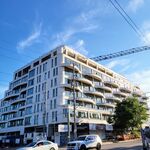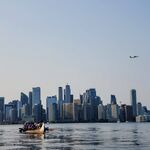Amare
Senior Member
That's a really touching message Yvan sent to his constituents. It's too bad that he's really delusional when it comes to this file.
The Montreal Metro trains are the same width as our streetcars. The light rail vehicles for the Crosstown LRT (and Finch West) will be wider than both our streetcars and Montreal Metro trains.
A quick search suggest the following:
- TTC SRT = 2490 mm
- Montreal trains = 2500 mm
- TTC streetcar = 2540 mm
- TTC LRT = 2650 mm
- Canada Line Vancouver = 3000 mm
- TTC subway = 3140 mm


The streetcars may be (4 cm) wider than the Montreal metro trains, but the layout of the new metro trains is much better for passenger circulation than the new Toronto streetcars. You don't have the double forward-facing seats at both sides of the car in the new metro except at the ends of the train.
E.g. this is very hard to move through if anyone is standing in the row:

but in the Montreal trains they have single seat rows on one side and double rows on the other side so it is still possible to move through:

E.g. this is very hard to move through if anyone is standing in the row:
but in the Montreal trains they have single seat rows on one side and double rows on the other side so it is still possible to move through:
Subways for all. How original.
I am curious as to what the math is regarding the hydro corridor west of Martin Grove.Which is why elevated is oh so beautiful.
That's a really touching message Yvan sent to his constituents. It's too bad that he's really delusional when it comes to this file.
Eglinton is 60-70 km/h driving speeds through Richview. Yeah, let's force commuters, many of them senior citizens, to cross into the road median to access an LRT.
I am curious as to what the math is regarding the hydro corridor west of Martin Grove.
- The transit line would be 5.0m above Martin Grove as it crosses.
- There is little ability for the elevated track to dip within the 100m from Martin Grove to the hydro corridor (maybe it could by a metre or 2).
- The "bridge" (support structure for elevated line) some type of enclosure around the elevated transit line (for the portion under the hydro lines) to reduce the required clearance from train to wires.
- I don't know the required clearance - but it seems like it might not be possible to squeeze the transit line above road and below the hydro lines.
- I would be interested to know if anyone knows what the actual numbers are.
It went at 5%. From Black Creek to the portal was 200 to 250m (the portal has some length from where tracks start to go underground to where tunnel box is fully underground). The road elevation also dropped 5m in this area - saving about 100m of transition. I also helped that there was no station at Black Creek.The LRT can handle an 8% incline. The requirement would be how much of a distance is needed at 8% to get from a level grade to an elevated grade to a below grade. At the Keelesdale portal, the trains will exit the tunnels at a side of a hill to the overpass at Black Creek Drive. There is no such hill between Martin Grove and the hydro lines.
However, the hydro lines could be raised up on higher towers at a cheaper cost, or buried for that portion as needed.
With at grade stops, it would be cheaper to provide accessibility. With above or below grade stations, they would require long ramps or elevators.
It went at 5%. From Black Creek to the portal was 200 to 250m (the portal has some length from where tracks start to go underground to where tunnel box is fully underground). The road elevation also dropped 5m in this area - saving about 100m of transition. I also helped that there was no station at Black Creek.
From 2012 EA revision.
View attachment 127072
The LRT can handle a 5% incline, streetcars can handle an 8% incline, subway trains require a smaller incline. The requirement would be how much of a distance is needed at 8% to get from a level grade to an elevated grade to a below grade.




